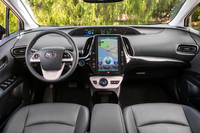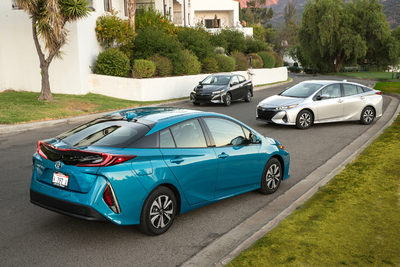2017 Toyota Prius Prime Advanced Review by Carey Russ +VIDEO
The newest member of the Prius family combines distinctive looks with exemplary fuel economy and the possibility of useful electric operation
DRIVING DOWN THE ROAD WITH CAREY RUSS
• SEE ALSO: Toyota Research and Buyers Guide
Toyota’s iconic Prius was all-new for 2016, so what’s with the new and different one for 2017? Did Toyota restyle it already? Not quite… Welcome the newest member of the Prius family, the Prius Prime. If anyone wondered what happened to the plug-in version of the previous generation, meet the next generation plug-in Prius.
 |
The Prime is instantly recognizable as a current Prius, but styling details front and rear are noticeably different. And there is an access hatch on the right rear fender, matching the fuel door on the left. That’s for the charger cable. Underneath, the 1.8-liter Atkinson-cycle engine, permanent-magnet AC synchronous traction motor, and motor-generator for starting the engine and recharging the hybrid battery pack are familiar — but the lithium-ion battery pack is larger in capacity with additional hardware and control circuitry to allow charging from an external source. And the starter motor-generator can work with the traction motor to deliver power to the front wheels. The combined power of the system is the same as in the standard Prius, 121 horsepower. The larger battery and associated hardware helps increase weight by about 325 pounds.
Range under electric-only power has increased from the old fifteen or so miles to twenty-five, at speeds up to 82 mph (130 kph). Default is for the Prime to run in EV mode when started, if the battery has enough charge. That can be deferred, with EV mode selected at the driver’s discretion, or an EV/Hybrid combination mode selected to optimize mileage by running in EV mode when that’s most efficient, and using the engine more when quick acceleration or hillclimbing demand power. Yes, that sounds like hybrid mode, and is, but with more electric use. EPA mileage estimates in hybrid mode are 55 mpg city, 53 highway, and 54 overall. EV mode is rated as 133 mpg-e. Charging time is rated as 5.5 hours on 110/120V — your wall socket — or two hours ten minutes at 220V, as from a commercial charging station or home high-voltage unit. When the battery charge drops below the EV minimum, no range anxiety. The Prime just reverts to regular hybrid mode. Unless someone forgot to add gasoline…
The 2017 Prius Prime comes in Plus, Premium, and Advanced grades. Compromises in comfort and convenience for high mileage and greater electric range are not required. All are well-equipped, with the Plus having LEDs for projector headlights, daytime running lights, and tail lights plus heated folding outside mirrors. Inside are heated front seats, automatic climate control, tilt- and telescope-adjustable steering wheel with controls for audio, climate, information, and Bluetooth® phone systems, plus Toyota’s Entune™ audio, navigation, and app system. And the Smart Key system with pushbutton start/stop, and power points and USB ports. Premium gets auto on/off headlights, SofTex synthetic leather seating, power adjustment for the driver’s seat, fancier interior trim, and Qi-compatible wireless device charging. Advanced means standard LED foglamps, rain-sensing wipers, remotely-controllable climate control, a color head-up display, and electronic safety features like blind-spot monitoring with rear cross-traffic alert and parking sonar. All models have Toyota’s Safety Sense P and Star Safety Systems as standard equipment. The Advanced gets the Safety Connect system as well.
I’ve just spent an interesting week with a Prime Advanced. It wasn’t all that much different from a similarly-equipped regular Prius Liftback, except of course for the styling and additional EV range. The Prime is strictly a four-seater, with a rear console similar to that in front — and that front console looks like it came from the Apple Store. Enhanced by the tablet-like extra-large center stack display. This is a high-tech electronic device masquerading as a motor vehicle so it might as well let you know that.
How does it work? Very well, unsurprisingly. The extra weight is noticeable, especially as the suspension seems to be more softly-tuned to compensate. Comfortable? Yes. Quick? Not really, but quick enough for everyday use and performance here is more about fuel economy than acceleration. For that, with sporadic plug-in charging and strategic use of EV mode, an easy 53 mpg despite near-continual admonishment from the economy nanny. That’s not significantly better than the regular Liftback, but especially with a vehicle like this, your mileage may vary… if you have a one-way commute of 25 miles or less and can charge both at home and work, you might go a long way between gasoline fill-ups. And unlike a pure EV, there’s good old infernal combustion for a backup, or for long trips far from charging stations or EV-friendly parking lots. The price premium could pay for a lot of unleaded regular, but in some places hybrids and EVs get special privileges including carpool lanes. If it’s not for everyone, the Prius Prime is more versatile than a pure EV or hydrogen fuel-cell vehicle like Toyota’s Mirai.
APPEARANCE: Speaking of the Mirai, the Prime is even closer to it in looks than the regular Liftback. The side profile is the same, as are the doors, hood, and fenders. I think — no chance to park next to a Liftback for detailed comparison. The Prime is about four inches longer because the ends are vastly different. The front brings a samurai helmet to mind, with quad small LED headlights on each side, a black center section, and, on upper grades, vertical LED running lights at the front corners. At the rear, first note the “double wave” hatch, a more complex design than the Liftback’s and made of carbon fiber to save weight. A similar double window is used, but here the vertical section is surrounded by a full-width taillight, LED of course, and more complex styling of the rear fascia. Despite a lack of rear wiper (aerodynamics…) visibility in rain is not a problem.
COMFORT: Inside, the most apparent difference from the Liftback is… who left their tablet stuck on the center stack? The 11.6-inch touchscreen, with capacitive-touch hard buttons for major functions, replaces the Liftback’s smaller screen and climate-control interface, and necessitates revised center vents. It looks appropriately high-tech, and works well enough, although glare intrudes at times. The main instruments are in their traditional (for a Prius) center location at the base of the windshield, ensuring that the driver moves eyeballs to maybe be more attentive. That display is bright and easily visible in all light, with the speedometer, fuel gauge, and multiple programmable information displays. The shift lever below it is a familiar Prius item although a the drive mode switch is joined by EV/HV and EV Auto switches instead of just an EV switch. EV/HV allows deferral of EV operation with a charged EV battery; EV Auto means more EV use than default hybrid mode. The front seats are comparable to those in the Liftback, here with the driver’s power-adjustable and SofTex leatherette. The rear, as mentioned, is strictly for two, with a useful console between. The cargo area floor is higher than in the Liftback because of the larger battery pack, but the rear seat does fold down 60/40 for hatchback versatility. The carbon-fiber hatch is light and easy to use. Be careful of road debris as there is no spare tire, just a sealant kit.
SAFETY: Every Prius Prime comes with all mandated safety equipment plus Toyota Safety Sense P, comprised of the Pre-Collision System with Detection, Lane Departure Alert with Steering Assist, Auto High Beams, and Full-Speed Radar Dynamic Cruise Control, and the Star Safety System of Enhanced Vehicle Stability Control, Traction Control, Antilock Brakes with Brake Assist and Electronic Brake-Force Distribution, and Smart Stop Technology. Advanced models have the Safety Connect® system of Emergency Assistance, Stolen Vehicle Locator, Roadside Assistance, and Automatic Collision Notification.
RIDE AND HANDLING: The Prime shares its unibody structure and fully-independent MacPherson strut/double wishbone suspension and electrically-assisted power steering with the Liftback, with retuned springs and shocks to deal with the extra weight. Sporty it’s not, but it is comfortable and quiet, especially in EV mode — where tire noise is about all there is. Steering, as in the Liftback, is vastly improved from earlier generations. The four-wheel disc brakes are aided by regenerative braking, and Toyota is one of the few manufacturers to have a shift mode — “B” — for extra regenerative braking when desired. Recharge your battery when coasting to a stop or going down a hill, and let the brake pads last longer.
PERFORMANCE: Here, the major difference between the Prime and the Liftback is the larger-capacity lithium-ion battery and possibility of external charging. And the “dual motor drive” that uses a one-way clutch allow the generator (MG1) to assist the traction motor (MG2) to deliver torque to the front wheels. Toyota hasn’t published power figures for the electric motors here, but if MG2 is the same as in the Liftback, it makes a maximum of 71 horsepower and 120 lb-ft of torque, add a bit more from MG1. The gasoline engine is the same Atkinson-cycle unit found in the Liftback, with 95 hp and 105 lb-ft, and maximum system horsepower is the same, at 121. Acceleration feels stronger in EV mode than hybrid — no surprise, look at the torque figures and realize that an electric motor makes maximum torque as soon as it rotates. In this context, “performance” is about fuel economy more than acceleration or top speed. And that will vary depending on driving style and charging frequency. I was constantly admonished by the eco-scoring software to reduce acceleration and use EV mode more often and still got 53 mpg. Impeding traffic is not in my game plan.
CONCLUSIONS: The newest member of the Prius family combines distinctive looks with exemplary fuel economy and the possibility of useful electric operation.
SPECIFICATIONS
2017 Toyota Prius Prime Advanced
Base Price $ 33,100
Price As Tested $ 36,305
Engine Type DOHC 16-valve aluminum alloy Atkinson-cycle inline 4-cylinder with VVT-i variable valve lift and cam phasing
Engine Size 1.8 liters / 110 cu. in.
Horsepower 95 @ 5200 rpm
Torque (lb-ft) 105 @ 3600 rpm
Traction Motor Type Permanent Magnet AC Synchronous
Hybrid Battery Pack 8.8 kWh Lithium-ion
Maximum Total System Horsepower 121
Transmission Computer-controlled CVT
Wheelbase / Length 182.9 in. / 106.3 in.
Curb Weight 3375 lbs.
Pounds Per Horsepower 27.9
Fuel Capacity 11.3 gal.
Fuel Requirement 87 octane unleaded regular gasoline
Tires P195/65R15 89S m+s Toyo Nano Energy
Brakes, front/rear vented disc / solid disc, with regenerative braking, ABS, EBD, BA standard
Suspension, front/rear independent MacPherson strut / independent double wishbone
Drivetrain front power unit, front-wheel drive
PERFORMANCE
EPA Fuel Economy - miles per gallon city / highway / observed 55 / 53 / 53
0 to 60 mph 11 sec
OPTIONS AND CHARGES
Universal Tablet Holder $ 99
Illuminated Door Sills $ 299
Alloy Wheel Locks $ 65
Paint Protection Film $ 395
15-inch Alloy Wheels $ 899
RS3200+/Glass Breakage Sensor $ 359
Carpet Floor and Cargo Mats $ 224



